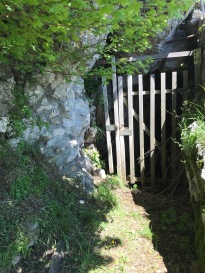We’ve all seen ruins that look ruined – the wobbly low lines of old stone that a Park Service guide or historical sign tells us are the original foundations of a 17th century church or fort. Picture broken low walls like that on about six levels of the steep crest of a mountain about 40 km from the Italian Adriatic.  The higher we climbed between these stone walls, along paths freshly weed-whacked (for us? – eight American journalism instructors who bring out several solicitous local dignitaries), the more ancient the history.
The higher we climbed between these stone walls, along paths freshly weed-whacked (for us? – eight American journalism instructors who bring out several solicitous local dignitaries), the more ancient the history.
The top two levels are maybe 10th or 11th century – the Dark Ages. Darker still: a cave here behind a locked gate is said to have held evidence of Neandertal Man, bones and stone weapons. Of course. Life between the fall of Rome and about 1400 was Dangerous – like pre-historical life before Rome. And this rocky promontory, Monte Copiolo, was a rare Safety. Our guide calls it the Helm’s Deep of Lord of the Rings. Or at least it became Safe when a few strong military leaders in the Carpegna family (circa 10th-11th C.) and then the Montefeltro family (12th-14th C.) built this defensible Castello (“castle” in this Italian sense means walled city).

A cave near the top of Il Castello di Monte Copiolo nel Montefeltro where Neadertal remains were found.
It’s hard to imagine this as a “city.” But all the pieces are here. A church and hospital on the lowest level, for pilgrims sojourning to or from Spain’s Santiago or the Holy Land, or victims of the Black Plague. A huge cistern under Count Montefeltro’s control. A quarry (the whole mountaintop is a quarry turned into a castello). A Rocca (fort) with space for knights (Cavalieri) to assemble and drill before suffering the kind of sword-piercing we saw in skulls in the museum in the village of Montecopiolo.
As we stand on the breathtaking summit, Rusty Greene, the JMU professor with theatrical poise (he was originally a theater director and professor), holds forth with a theory. Is it possible, he asks, that the spark that lit the Renaissance began right here? Here on this patch of grass, Montefeltro could imagine the Piazza Ducale of Urbino? Here were Urbino’s walls against enemies and the houses of artisans, the Duomo and Palazzo, all in miniature. It seems a plausible theory, since our guide, University of Urbino archeology professor Daniele Sacco, had just told us that this mountaintop did serve as a prototype for Urbino, where the 15th century Frederico Montefeltro conjured up the Renaissance with painters Raphael and Piero di Francesco and philosophers and mathematicians extemporizing in the palace of Castiglione’s The Courtier.

Professor Daniele Sacco and the skull of a head-bashed knight.
But Professor Sacco, who looks like a young courtier in a Zeffirelli movie, says no. There was nothing on this mountain to prefigure the Renaissance (although plenty of lovely pottery shards in the museum below). It was all about power, he says. The Montefeltros were military overlords. What they developed at Montecopiolo was confidence in their power, their military might. So when they took over Urbino, 30 km to the southeast, they built it into a showcase for their power. The philosophers and mathematicians were summoned from Northern Europe. And the art grew from there.
I gaze at the mountains and the sea from this height. San Marino. San Leo. Gorgeous clouds and the green spring land “plotted and pierced—fold, fallow, and plow” (from Hopkins’ poem). Maybe the Renaissance, the re-birth of light out of Darkness, came from so much gazing at such beauty from such a height for two or three hundred years. In relative safety.
